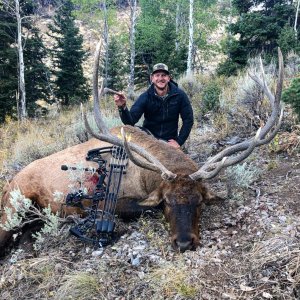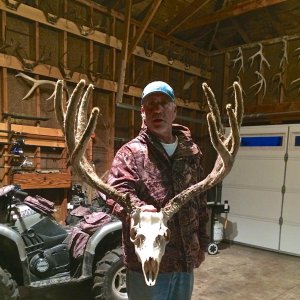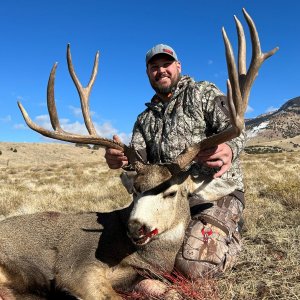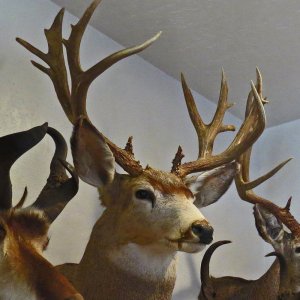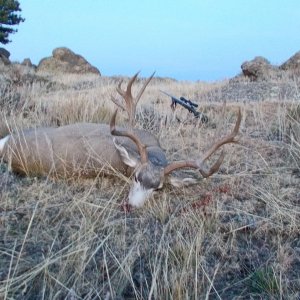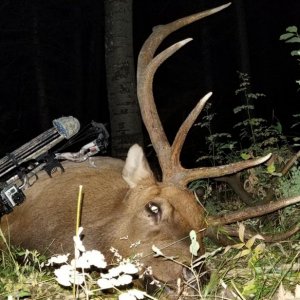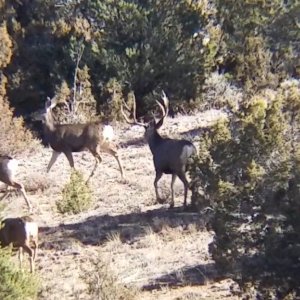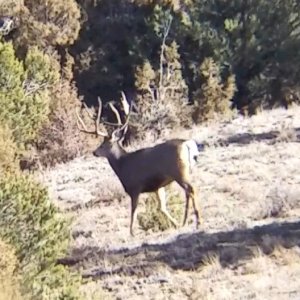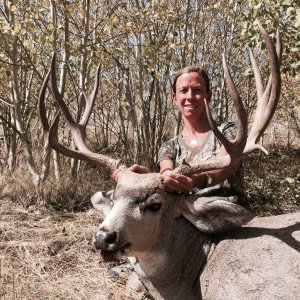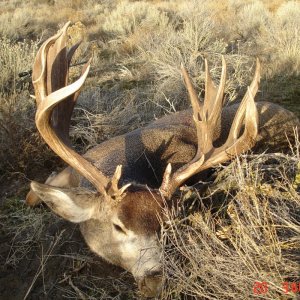2lumpy
Long Time Member
- Messages
- 8,481
Here are the questions I've compiled and forward to the research biologists and the Utah DWR for the Monroe Unit - Coyote/Fawn Survival and Cougar Research study. The meeting will be held at the Sevier County Building, at 250 North Main Street in Richfield, from 6-9pm on February 25.
These questions have come from local sportsmen and others from outside the area, they aren't in any specific order, I just put them together as they came in to me, some came off the internet forums, some came from phone calls, some came from coffee shop conversations, some I don't even remember who asked. I'm sure there are other questions but they will need to be asked at the meeting in as much as these have been sent to Juston Shannon (UDWR) to give to the presenters.
Thanks to those of you that called or sent me e-mails etc.
Here are the questions:
Questions, in no specific order, for the Cougar, Coyote, Fawn Survival Research on Monroe Mountain Unit Meeting, February 25, 2014.
Many sportsmen and professional biologists believe the Monroe Unit cougar and coyote/fawn study a huge waste of time and limited money.
a) One group believes they all ready know, from past research, that reducing predators, specifically coyote and cougars does not generate a significant increase fawn survival.
b) The other group believes they all ready know, from past research, that reducing predators, specifically coyote and cougars does in fact generate a significant increase in fawn survival.
Why do you believe we should have started this study and why do you believe we should continue, based on the data that has been collected thus far. What more is there to learn?
Fawns/Coyotes - So now what are the birth/survival trends of fawns? Is it better because of coyote reduction or something else like less winter kill? Does the research link coyote population to fawn survival?
Cougars- What are we learning from the cougar study? How many are there? Is the population growing or shrinking? How frequently does a cougar kill? What age of deer do cougars target?
How many coyotes were killed on the north end of the Monroe Unit by the helicopters on the first year of the study? What were the killing conditions, ie: weather etc?
How many were killed on the north end on the second year. What were the killing conditions, ie: weather etc?
What are the buffer zones for the north and south parts of the Unit. Is there a map of the buffer zones we can see?
Did you kill coyotes in the buffer zone (next to the Unit), on the north end in year one and year two, if so, how many?
Have any of the collared deer from the Monroe moved off the Unit. How far have collared moved on the unit?
How do you know when you have killed enough coyote or cougars to change alter the fawn survival rate?
How many cougars are on the Monroe? How do you know that? What percentage of error do you use in your cougar estimate. With elk the Division uses 20 -25%, what error factor are you using for cougars?
We need to know what their assessment is in regards to habitat. We need to know specifically if the habitat -- winter range specifically-- can support more deer and what is the realistic number for population. If they determine that the habitat can not support more growth then we are just throwing money away in increased predator control. If there is more room for growth then we need to stay serious about predator reduction and even increase our efforts to reduce mortality by predators.
How many deer are there on the Unit? What is the carrying capacity of the Unit for deer? How do you determine the carrying capacity of the Monroe? Do you use the same method to determine carrying capacity on the Monroe as you use on the West Desert, Henry Mountains, Logan Canyon, the Wasatch Front?
Nobody is actually out counting mule deer to determine total population, how to you come up with your estimate of total deer on a unit? I'm asking this because I would like to know if there is any correlation between total coyote carrying capacity and the fawn survival abilities of a deer herd when it approaches total unit carrying capacity. Do you believe there is a correlation and if so, what would it be? When a deer herd reaches some thing near total carrying capacity on a unit, can it support a coyote population that has reached it's carrying capacity. Does this ever happen in the real world or only in theory?
Is anyone in the study group checking to see if there are any relevant issues between reducing coyotes and it's effect on the behavior of cougars and visa versa, as it relates to fawn survival? If you reduce cougar populations do coyote populations increase, and visa versa? Is data from this specific study been collected and analyzed regarding this question, that can be released?
I think habitat, weather, infectious disease, high speed roads, poachers, etc. etc, are killing more deer than cougars or coyotes. How can your very small Monroe Mountain project prove that droughts and heavy winters are not the primary reason for low fawn counts? What's your sample size? Who say?s it's conclusive? As a research biologist, don't you think a two to four year study, focused on cougars and coyotes is too short to learn much of anything, much less justify killing a large number of predators with the simple hope it will help deer?
How much has been spend killing coyotes on the Monroe in the last two years, including helicopters, labor, sportsmen?s bounties, professional trappers, etc. Do not include any of the research related costs, just the actual cost to killing x number to the State for killing x number of coyotes?
What are the fawn/doe ratios on the Monroe now? What were they before the study started?
Do we know what the fawn/doe ratios were on the north end separated from the south end before the study started two years ago. I mean, can we compare fawn/doe on the north and south before the study, to fawn/doe now that the study is underway?
What a waste, nobody believes these studies regardless how they turn out. When was the last time you every heard of the outcome of a DWR study? These research projects get written up and shoved in some university's filing cabinet and never see the light of day. Let's be honest, isn't this just another bunch of college kids working on a PhD. project? What good can come from this?
Some people think that fawn survival is almost entirely tied to weather conditions. As you compare the weather on the South end of the Monroe to the North end, as there been any notable difference? More or less snow, rain, hot, dry etc. that could reflect a difference in fawn survival from north to south, without regard to the coyote/cougar reduction project?
Secondly, are there any other factors besides weather that may be causing a difference between the fawn survival between the north end and the south end besides the predator reduction?
What measurement standard are you using to determine if there has been a adequate coyote reduction on the Monroe Unit? Do you know how many coyotes you had to begin with, do you know how many you need to remove in order to know if you have removed enough to measure an effect on fawn survival? What does adequate remove mean, as to the Monore Unit? If there are 500 coyotes on the Monroe Mt. and you kill 250 of them, is that enough? If there are 1500 is killing 200 enough? How many coyotes did we have and how many are left now? Who decides when enough is enough?
As you have captured fawns at or near their birth dates, do you have a chart that shows the birth dates of all those captured? I'd be interested in know the actual dates the fawns are born each year.
On the Monroe, of the captured and monitored deer, what percentage are killed by predators, road kills, poaching, disease, other causes? Do you believe these percentage are similar to the percentages on the total deer mortality of all deer on the unit?
How much of this information that your getting off the Monroe can be used to manage predators and improve fawn survival on other units in the State? Are you going to need to do a study on every unit? Why or why not?
Do predators ever over populate like deer and elk?
Can someone in the research group compile the data and with a brief explanation of the latest information and publish it on the Internet like they have been doing on the Holden/Phavant Unit Deer Transplant?
If circumstances like weather, politics, funding, etc interrupt the study, are there contingencies in place that will allow it to continue until a proven conclusion can be reached?
These questions have come from local sportsmen and others from outside the area, they aren't in any specific order, I just put them together as they came in to me, some came off the internet forums, some came from phone calls, some came from coffee shop conversations, some I don't even remember who asked. I'm sure there are other questions but they will need to be asked at the meeting in as much as these have been sent to Juston Shannon (UDWR) to give to the presenters.
Thanks to those of you that called or sent me e-mails etc.
Here are the questions:
Questions, in no specific order, for the Cougar, Coyote, Fawn Survival Research on Monroe Mountain Unit Meeting, February 25, 2014.
Many sportsmen and professional biologists believe the Monroe Unit cougar and coyote/fawn study a huge waste of time and limited money.
a) One group believes they all ready know, from past research, that reducing predators, specifically coyote and cougars does not generate a significant increase fawn survival.
b) The other group believes they all ready know, from past research, that reducing predators, specifically coyote and cougars does in fact generate a significant increase in fawn survival.
Why do you believe we should have started this study and why do you believe we should continue, based on the data that has been collected thus far. What more is there to learn?
Fawns/Coyotes - So now what are the birth/survival trends of fawns? Is it better because of coyote reduction or something else like less winter kill? Does the research link coyote population to fawn survival?
Cougars- What are we learning from the cougar study? How many are there? Is the population growing or shrinking? How frequently does a cougar kill? What age of deer do cougars target?
How many coyotes were killed on the north end of the Monroe Unit by the helicopters on the first year of the study? What were the killing conditions, ie: weather etc?
How many were killed on the north end on the second year. What were the killing conditions, ie: weather etc?
What are the buffer zones for the north and south parts of the Unit. Is there a map of the buffer zones we can see?
Did you kill coyotes in the buffer zone (next to the Unit), on the north end in year one and year two, if so, how many?
Have any of the collared deer from the Monroe moved off the Unit. How far have collared moved on the unit?
How do you know when you have killed enough coyote or cougars to change alter the fawn survival rate?
How many cougars are on the Monroe? How do you know that? What percentage of error do you use in your cougar estimate. With elk the Division uses 20 -25%, what error factor are you using for cougars?
We need to know what their assessment is in regards to habitat. We need to know specifically if the habitat -- winter range specifically-- can support more deer and what is the realistic number for population. If they determine that the habitat can not support more growth then we are just throwing money away in increased predator control. If there is more room for growth then we need to stay serious about predator reduction and even increase our efforts to reduce mortality by predators.
How many deer are there on the Unit? What is the carrying capacity of the Unit for deer? How do you determine the carrying capacity of the Monroe? Do you use the same method to determine carrying capacity on the Monroe as you use on the West Desert, Henry Mountains, Logan Canyon, the Wasatch Front?
Nobody is actually out counting mule deer to determine total population, how to you come up with your estimate of total deer on a unit? I'm asking this because I would like to know if there is any correlation between total coyote carrying capacity and the fawn survival abilities of a deer herd when it approaches total unit carrying capacity. Do you believe there is a correlation and if so, what would it be? When a deer herd reaches some thing near total carrying capacity on a unit, can it support a coyote population that has reached it's carrying capacity. Does this ever happen in the real world or only in theory?
Is anyone in the study group checking to see if there are any relevant issues between reducing coyotes and it's effect on the behavior of cougars and visa versa, as it relates to fawn survival? If you reduce cougar populations do coyote populations increase, and visa versa? Is data from this specific study been collected and analyzed regarding this question, that can be released?
I think habitat, weather, infectious disease, high speed roads, poachers, etc. etc, are killing more deer than cougars or coyotes. How can your very small Monroe Mountain project prove that droughts and heavy winters are not the primary reason for low fawn counts? What's your sample size? Who say?s it's conclusive? As a research biologist, don't you think a two to four year study, focused on cougars and coyotes is too short to learn much of anything, much less justify killing a large number of predators with the simple hope it will help deer?
How much has been spend killing coyotes on the Monroe in the last two years, including helicopters, labor, sportsmen?s bounties, professional trappers, etc. Do not include any of the research related costs, just the actual cost to killing x number to the State for killing x number of coyotes?
What are the fawn/doe ratios on the Monroe now? What were they before the study started?
Do we know what the fawn/doe ratios were on the north end separated from the south end before the study started two years ago. I mean, can we compare fawn/doe on the north and south before the study, to fawn/doe now that the study is underway?
What a waste, nobody believes these studies regardless how they turn out. When was the last time you every heard of the outcome of a DWR study? These research projects get written up and shoved in some university's filing cabinet and never see the light of day. Let's be honest, isn't this just another bunch of college kids working on a PhD. project? What good can come from this?
Some people think that fawn survival is almost entirely tied to weather conditions. As you compare the weather on the South end of the Monroe to the North end, as there been any notable difference? More or less snow, rain, hot, dry etc. that could reflect a difference in fawn survival from north to south, without regard to the coyote/cougar reduction project?
Secondly, are there any other factors besides weather that may be causing a difference between the fawn survival between the north end and the south end besides the predator reduction?
What measurement standard are you using to determine if there has been a adequate coyote reduction on the Monroe Unit? Do you know how many coyotes you had to begin with, do you know how many you need to remove in order to know if you have removed enough to measure an effect on fawn survival? What does adequate remove mean, as to the Monore Unit? If there are 500 coyotes on the Monroe Mt. and you kill 250 of them, is that enough? If there are 1500 is killing 200 enough? How many coyotes did we have and how many are left now? Who decides when enough is enough?
As you have captured fawns at or near their birth dates, do you have a chart that shows the birth dates of all those captured? I'd be interested in know the actual dates the fawns are born each year.
On the Monroe, of the captured and monitored deer, what percentage are killed by predators, road kills, poaching, disease, other causes? Do you believe these percentage are similar to the percentages on the total deer mortality of all deer on the unit?
How much of this information that your getting off the Monroe can be used to manage predators and improve fawn survival on other units in the State? Are you going to need to do a study on every unit? Why or why not?
Do predators ever over populate like deer and elk?
Can someone in the research group compile the data and with a brief explanation of the latest information and publish it on the Internet like they have been doing on the Holden/Phavant Unit Deer Transplant?
If circumstances like weather, politics, funding, etc interrupt the study, are there contingencies in place that will allow it to continue until a proven conclusion can be reached?

